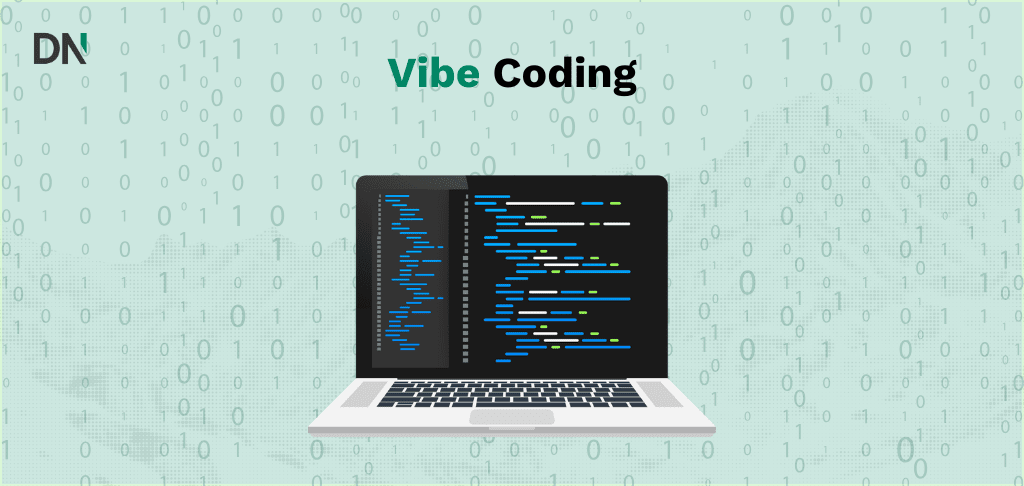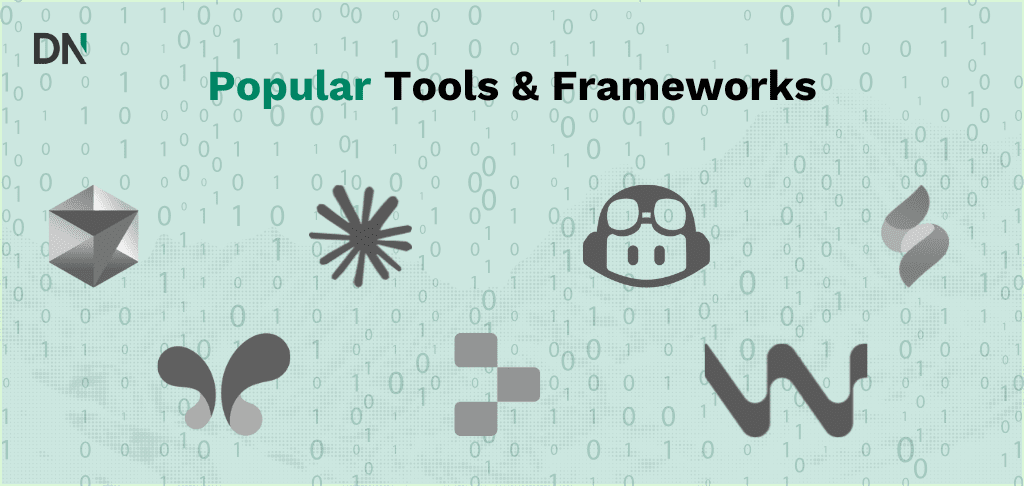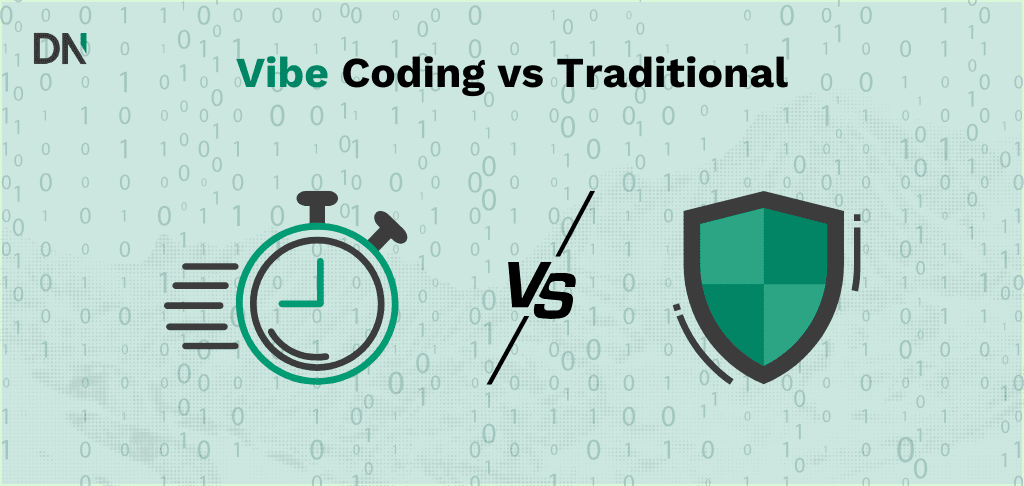Software development is rapidly changing. What once required extensive technical training and months of careful coding can now be accomplished through natural conversation with artificial intelligence. This shift, known as vibe coding, has recently gained a lot of traction, changing how applications are built, who can build them, and how quickly ideas can become functional software.
Vibe coding represents more than just a new development methodology, it signals a democratization of software creation that could impact every business, regardless of size or industry. For companies, understanding this trend is crucial for staying ahead of the technological curve and helping clients navigate the evolving landscape of AI-assisted development. In this article we will expand on vibe coding. We’ll explain what vibe coding is, the benefits and downsides, when to use it and when not to, and we look at vibe coding versus traditional programming.

What is vibe coding?
Definition and origins
Vibe coding is an artificial intelligence-assisted software development technique that enables users to create functional applications through natural language prompts rather than traditional manual programming. The term was coined by Andrej Karpathy, co-founder of OpenAI and former AI leader at Tesla, in February 2025.
Karpathy described the approach as “fully giving in to the vibes, embracing exponentials, and forgetting that the code even exists”. This philosophy represents a fundamental shift from the precise, methodical nature of traditional programming to an intuitive, experimental approach powered by large language models (LLMs).
The concept builds on Karpathy’s earlier assertion from 2023 that “the hottest new programming language is English,” highlighting how advanced AI capabilities have made natural language a viable programming interface. By March 2025, the term had gained such widespread recognition that it was listed in the Merriam-Webster Dictionary as a “slang & trending” term.
What are the key characteristics of vibe coding?
Vibe coding is distinguished by several core characteristics that set it apart from traditional development approaches:
- Natural language interface: Developers describe project requirements and functionality using plain English rather than programming syntax. This conversational approach makes software development accessible to non-technical users while accelerating the process for experienced developers.
- AI-driven code generation: Large language models analyze natural language descriptions and automatically generate functional code, handling implementation details without human intervention. The AI manages everything from basic algorithms to complex application structures.
- Iterative refinement: Rather than writing perfect code from the start, vibe coding embraces a “code first, refine later” mindset. Users test AI-generated solutions and provide feedback through additional prompts to improve functionality.
- Minimal code review: A defining aspect of vibe coding is the acceptance of AI-generated code without comprehensive human review. As programmer Simon Willison noted, true vibe coding involves using code “without full understanding” of its underlying mechanics.
How vibe coding works
The process
Implementing vibe coding follows a straightforward four-step process that transforms ideas into functional applications:
Step 1: Choose an AI coding platform – Select an appropriate AI assistant based on technical requirements, performance needs, and budget constraints. Popular platforms include Replit, Cursor, and various cloud-based development environments.
Step 2: Define requirements – Provide clear, specific prompts describing the intended functionality. The quality and specificity of these prompts directly impact the output quality. For example, instead of saying “create an app,” a more effective prompt would be: “Create a startup name generator app with a text input for industry selection and a button that displays 10 creative company names when clicked”.
Step 3: Code refinement – Review the basic generated code and identify areas for improvement. This involves testing the application and providing additional prompts to refine functionality, fix issues, or add features through conversational feedback.
Step 4: Final review and deployment – Conduct a final assessment of the refined code before deployment. While this step involves less comprehensive review than traditional development, it ensures the application meets basic functionality requirements.

Popular tools and platforms
The vibe coding ecosystem includes several powerful platforms designed to streamline AI-assisted development:
Google’s AI development platforms offer comprehensive solutions for vibe coding. Google Cloud AI Studio provides the quickest path from idea to live application, often requiring just a single prompt with live previews and direct deployment to Cloud Run for public access. Firebase Studio complements this by excelling at building production-ready applications with robust backend features like user authentication and databases, creating detailed app blueprints for review before generating working prototypes.
Cursor serves as an AI-native code editor built on VS Code, integrating advanced models like Claude Sonnet for writing, editing, and understanding code. Its Composer feature enables task delegation to AI agents that understand context across multiple files.
GitHub Copilot remains the market leader, with 42% of surveyed engineers naming it their primary AI coding tool. Microsoft’s solution offers comprehensive code suggestions and integrates seamlessly with existing development workflows.
Replit provides a versatile browser-based development environment with built-in AI assistance through Ghostwriter, making it ideal for rapid prototyping and collaborative development without local setup requirements.
Claude Code enhances the development experience with Anthropic’s Claude AI models, offering sophisticated code generation, debugging assistance, and natural language programming capabilities. The platform excels at understanding complex coding requirements and generating clean, well-documented code across multiple programming languages.
Windsurf delivers a cloud-native IDE designed specifically for vibe coding workflows, featuring real-time collaboration, integrated AI assistance, and seamless deployment options. The platform combines the familiarity of traditional development environments with advanced AI capabilities for rapid application development and testing.
What are the benefits of vibe coding?
Speed and efficiency
Vibe coding delivers unprecedented acceleration in software development timelines. Projects that traditionally required weeks or months can now be completed in hours or days. Studies indicate that organizations using vibe coding approaches report up to 55% faster project completion compared to traditional manual coding.
This acceleration proves particularly valuable for rapid prototyping and minimum viable product (MVP) development. Businesses can quickly validate ideas, test market demand, and iterate on concepts without significant upfront investment in development resources. The ability to move from concept to functional prototype within hours enables more agile business strategies and faster response to market opportunities.
Innovation and creativity
By automating routine coding tasks, vibe coding frees developers to focus on high-level problem-solving and creative solution design. Rather than spending time on syntax and implementation details, teams can concentrate on user experience, business logic, and innovative features that differentiate their products.
This shift enables what industry experts call “problem-first approach” development , where solving user needs takes precedence over technical constraints. Teams can experiment with multiple solutions rapidly, testing different approaches without the traditional time investment required for manual implementation.
The creative benefits extend beyond individual developers to entire organizations. Non-technical team members can contribute directly to application development, bringing domain expertise and user insights that might otherwise be lost in translation between business requirements and technical implementation.
Accessibility and democratization
Vibe coding dramatically lowers the barrier to entry for software development. Individuals without programming backgrounds can create functional applications by describing their needs in plain language, democratizing access to software creation capabilities.
This accessibility has profound implications for business innovation. Domain experts who understand industry-specific problems can now build solutions directly rather than relying on technical intermediaries. Small businesses and startups gain access to custom software development without the traditional cost barriers associated with hiring specialized developers.
What are the risks and limitations of vibe coding?
Security vulnerabilities
Vibe coding introduces significant security risks that organizations must carefully consider. AI-generated code often contains security flaws and outdated practices that can create vulnerabilities in production systems. Research indicates that 9 out of 10 AI-generated projects contain basic security vulnerabilities that non-technical users typically cannot identify or resolve.
The rapid development pace enabled by vibe coding can exacerbate these security issues, as teams may rush AI-generated code into production without adequate security review. Unlike traditional development where security considerations are built into the coding process, vibe coding’s “black box” approach can obscure potential vulnerabilities until they’re exploited.
Organizations implementing vibe coding must establish robust security scanning processes and ensure that AI-generated code undergoes appropriate security review before deployment. DataNorth AI’s EU AI Act compliance service can help businesses navigate the regulatory and security implications of AI-assisted development.
Technical debt and maintainability
Vibe coding can rapidly accumulate technical debt as AI-generated solutions may not follow established coding standards or architectural best practices. When applications are “stitched together by vibes alone,” the resulting codebase often lacks the structure and documentation necessary for long-term maintenance.
Debugging AI-generated code presents unique challenges since developers may not fully understand the underlying logic and implementation details. This knowledge gap becomes particularly problematic when applications require updates, bug fixes, or integration with other systems. The dynamic nature of AI code generation can also produce inconsistent coding patterns that complicate maintenance efforts.
Scale presents additional challenges, as vibe coding tools typically excel with small to medium-sized projects but may struggle with complex, distributed applications requiring sophisticated architectural considerations. Organizations planning to scale vibe-coded applications often need to rebuild or significantly refactor their solutions.
Quality and reliability concerns
AI language models, despite their impressive capabilities, can produce code with functional bugs, logical errors, or performance issues that may not be immediately apparent during initial testing. The conversational refinement process, while intuitive, doesn’t guarantee comprehensive quality assurance or systematic testing coverage.
Studies indicate that 25% of developers estimate that one in five AI-generated suggestions contains factual errors or misleading code. For production environments or applications handling sensitive data, these error rates represent unacceptable risks that require additional quality control measures.
The reliability concerns extend to AI model limitations in handling novel or complex problems. While AI excels at generating standard algorithms and common functionality patterns, it struggles with unique requirements or cutting-edge technical challenges that require original problem-solving approaches.
Vibe coding vs traditional programming
Understanding the key differences between vibe coding and traditional programming approaches is crucial for making informed technology decisions:
| Feature | Vibe coding | Traditional programming |
| Code creation | AI-generated from natural language prompts | Manual coding line by line |
| Developer role | Prompter, guide, tester, refiner | Architect, implementer, debugger |
| Technical expertise required | Lower (understanding of desired functionality) | Higher (knowledge of programming languages) |
| Primary input method | Natural language descriptions | Precise code syntax |
| Development speed | Faster, especially for prototyping | Generally slower, more methodical |
| Error handling | Refinement through conversational feedback | Manual debugging based on code comprehension |
| Learning curve | Lower barrier to entry | Often steep |
| Code maintainability | Depends on AI output quality and human review | Relies on code quality and developer skill |
| Scalability | Suitable for small to medium projects | Highly scalable for complex systems |
| Security control | Platform-managed with limited customization | Complete control over security measures |
| Best use cases | Rapid prototypes, MVPs, personal projects | Production systems, enterprise applications |
When to use vibe coding
Vibe coding proves most effective in specific scenarios where speed and accessibility outweigh concerns about code complexity or long-term maintenance:
Rapid prototyping and proof-of-concept development represents the strongest use case for vibe coding. When validating business ideas or demonstrating functionality to stakeholders, the ability to create working prototypes in hours rather than weeks provides tremendous value. This speed enables more iterative design processes and faster market validation.
Internal tools and automation benefit significantly from vibe coding approaches. Organizations can quickly build custom dashboards, data processing scripts, or workflow automation tools without extensive development investment. These internal applications typically have lower security and scalability requirements, making them ideal vibe coding candidates.
Educational and experimental projects leverage vibe coding’s accessibility to help teams learn new technologies or explore innovative concepts. The low barrier to entry enables experimentation that might not be feasible with traditional development approaches.
MVP development for startups has embraced vibe coding extensively. Recent data shows that 25% of Y Combinator startups in their Winter 2025 batch built 95% of their codebase using AI assistance , demonstrating the approach’s viability for early-stage companies focused on rapid market entry.

When not to use vibe coding
Certain scenarios require the precision and control that traditional programming provides:
Production systems handling sensitive data require comprehensive security review and custom security measures that vibe coding typically cannot provide. Financial applications, healthcare systems, and other regulated industries need the detailed security control that manual programming enables.
Large-scale, long-term applications benefit from the architectural planning and structured development that traditional programming provides. Complex systems requiring integration with multiple external services, high-performance requirements, or extensive customization exceed the capabilities of most vibe coding tools.
Mission-critical applications where reliability is paramount should avoid vibe coding approaches. Systems where failures could result in safety risks, financial losses, or operational disruptions require the comprehensive testing and validation that traditional development methodologies provide.
Best practices for safe vibe coding
Security guidelines
Organizations implementing vibe coding must establish comprehensive security frameworks to mitigate inherent risks:
Implement mandatory code review processes for all AI-generated code before production deployment. Even when embracing the “vibe” philosophy, critical business applications require human security expertise to identify potential vulnerabilities that AI might introduce.
Use automated security scanning tools to supplement human review. Static analysis security testing (SAST) and dynamic analysis security testing (DAST) tools can identify common vulnerability patterns in AI-generated code, providing an additional safety layer.
Establish clear boundaries for vibe coding usage within the organization. Define which types of applications and use cases are appropriate for vibe coding versus traditional development, ensuring that high-risk systems receive appropriate development oversight.
Maintain separation between experimental and production environments. Vibe coding experimentation should occur in isolated environments that cannot impact production systems or sensitive data, reducing the risk of accidental security breaches.
Quality assurance
Maintaining code quality requires systematic approaches that complement vibe coding’s rapid development cycle:
Combine vibe coding with traditional testing methodologies. While AI can generate functional code quickly, comprehensive testing strategies including unit tests, integration tests, and user acceptance testing remain essential for quality assurance.
Ensure understanding of critical code components. While vibe coding philosophy embraces code acceptance without full comprehension, production systems require that team members understand at least the high-level architecture and critical business logic components.
Implement proper documentation practices for AI-generated solutions. Document the prompts used to generate code, the intended functionality, and any modifications made during the refinement process. This documentation proves essential for future maintenance and troubleshooting.
Establish version control and change management processes. AI-generated code should follow the same governance processes as manually written code, including proper branching strategies, code reviews, and deployment procedures.
The future of software development
Industry trends
The software development industry is experiencing rapid transformation driven by AI-assisted coding adoption. By 2030, industry forecasts predict that 25% of Y Combinator startups will use AI to generate most of their code, with routine tasks becoming 80% automated and project completion accelerating by up to 55%.
AI-generated pipelines and autonomous software development lifecycle loops are emerging as the next evolution. These systems will handle entire development workflows, from requirements gathering through deployment and monitoring, allowing human developers to focus on strategy, ethics, and oversight rather than implementation details.
Convergence of development approaches is eliminating traditional boundaries between low-code, no-code, and professional coding. Modern platforms increasingly merge visual development tools with natural language prompts and traditional coding capabilities, creating unified interfaces that support different skill levels and development approaches.
Enterprise adoption is accelerating rapidly. Recent data indicates that 82% of companies now use agentic AI for software development tasks, up from just 50% in December 2024. This represents a fundamental shift in how organizations approach software development.
Impact on developers
The developer role is evolving from code implementer to AI orchestrator and strategic architect. Rather than writing every line of code manually, developers increasingly focus on defining requirements, reviewing AI outputs, and ensuring quality and security standards.
Skill requirements are shifting toward prompt engineering, AI tool management, and solution architecture. Traditional programming skills remain valuable, but the ability to effectively collaborate with AI systems becomes increasingly important for career advancement.
Job market transformation is already evident in hiring practices. Major companies including Visa, DoorDash, and Roblox now include “AI coding fluency” in job descriptions and specify that engineers should use AI tools for 50% or more of their workflow.
Multimodal development environments are emerging, incorporating voice, visual, and text-based coding interfaces. These advances promise to make software development more intuitive and accessible while enhancing productivity for experienced developers.
Getting started with vibe coding
Implementation steps
Organizations interested in exploring vibe coding should follow a systematic implementation approach:
1. Start with low-risk, experimental projects to build familiarity with AI-assisted development tools and understand their capabilities and limitations. Internal tools, prototypes, and proof-of-concept applications provide ideal starting points that minimize potential business impact.
2. Choose appropriate AI coding tools based on team skill levels, project requirements, and budget constraints. GitHub Copilot leads market adoption with 42% market share, while specialized platforms like Cursor and Replit offer different advantages for specific use cases.
3. Establish security and quality guidelines before expanding vibe coding usage. Define code review processes, security scanning requirements, and documentation standards that align with organizational risk tolerance and compliance requirements.
4. Train team members on best practices for prompt engineering, AI tool usage, and quality assurance. Understanding how to effectively communicate with AI systems and evaluate outputs becomes crucial for successful implementation.
5. Gradually expand usage based on success metrics and lessons learned from initial projects. Monitor development speed, code quality, and security outcomes to guide decisions about broader organizational adoption.
Conclusion
Vibe coding represents a fundamental shift in software development that promises to democratize application creation while accelerating innovation cycles. The approach offers significant benefits for rapid prototyping, internal tool development, and MVP creation, enabling organizations to validate ideas and respond to market opportunities faster than ever before.
However, successful vibe coding implementation requires careful consideration of security, quality, and maintainability challenges. Organizations that thoughtfully integrate vibe coding practices, with proper guardrails, training, and expert guidance, can gain competitive advantages while avoiding common pitfalls.
The future of software development will likely involve hybrid approaches that combine the speed and accessibility of vibe coding with the precision and control of traditional programming. Businesses that understand both methodologies and apply them strategically will be best positioned to leverage AI-assisted development for sustainable growth and innovation.
DataNorth AI stands ready to help organizations navigate this transition, providing the expertise, training, and strategic guidance necessary to harness vibe coding’s potential while maintaining appropriate risk management and quality standards. If you are interested to learn more on vibe coding and give your team the proper tools and guidelines, have a look at our Vibe Coding Workshop. The vibe coding revolution is here, the question is not whether to adapt, but how quickly and effectively your organization can embrace this transformative approach to software development.






